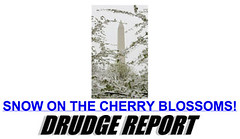The Pew Research Center‘s Project for Excellence in Journalism has released a study showing that while news sites depend a great deal on Google’s twin engines of search and news, which drives approximately 30% of these sites’ traffic, there’s another major source at work. Facebook and Twitter drive some traffic. But the surprising source of referrals comes from a single site — the Drudge Report, a 14-year-old site founded by Matt Drudge and most notorious for its coverage of the Monica Lewinsky scandal.
The Drudge Report alone drives about 7% of traffic to news sites. Facebook follows, providing about 3.3%, with Twitter next driving about 1%. (The bulk of traffic — about 40% — comes from direct URL access, typing in a domain name or using a bookmark.)
While it’s arguable whether Google’s news and search algorithms rise to the level of curation, it’s notable that the Drudge Report, which is curated by real people, has such an effect on traffic. As David Carr of the New York Times writes:
A big part of the reason he is such an effective aggregator for both audiences and news sites is that he actually acts like one. Behemoth aggregators like Yahoo News and The Huffington Post have become more like fun houses that are easy to get into and tough to get out of. Most of the time, the summary of an article is all people want, and surfers don’t bother to click on the link. But on The Drudge Report, there is just a delicious but bare-bones headline, there for the clicking. It’s the opposite of sticky, which means his links actually kick up significant traffic for other sites.
It’s an interesting set of observations, with many points of relevance for scholarly publishers:
- Drudge rewrites headlines, making them more interesting and relevant
- Drudge selects and gangs stories, curating a flood of news into a set of related perspectives on the day’s events
- Drudge doesn’t editorialize beyond the headline rewrite — it just sends you on your way
- Drudge has become a central hub for news junkies, so it’s a place to start for the current smart set
Imagine a similar service for scientists — juicier, clearer headlines; a smartly selected list of the most interesting content; no time-wasting elaboration; and a virtuous cycle of serendipity and connection. Such a nice little service targeted at the right specialty or field could become a central zone of interest for researchers and practitioners. There’s a lot to learn from the Drudge approach.
Curation succeeds because despite the power of the network effect and connectivity, finding stuff is still a pain, and discovering things is still a joy. Ethan Zuckerman has captured a fascinating keynote about the emergence of cities, the search for connectedness and serendipity, and the “two steps backward” online experience:
Like everyone else, I’m experiencing a shift in how I get news about the world. In the pre-web world and early web days, news of the world came primarily through curated media – broadcast television, newspapers, magazines. There were – and are – reasons to distrust curators, but there’s a critical aspect of their work I believe we need to preserve as we move towards new models for organizing news. Curators implicitly tell us what they believe we need to know about the world. High quality curators often have a broader view of the world than individuals have, and well-curated media often demands we pay attention to people, places and issues we might have otherwise ignored. On the other hand, curators invariably have biases, and the ability to seek information that appeals to our own interests and preferences is one of the most powerful capacities the modern web has put in our hands. . . . We need mechanisms to ensure that search gets complemented with serendipity.
Journals are one form of curation we’re familiar with, but it’s a clumsy form — articles appear roughly in the order submitted, editors are loathe to obviously favor one article over another, and titles are usually not as pointed or appealing as they might be. Clearly, there is room for another approach. But could an academic curator get out of his or her own way as efficiently as Drudge does? Or would desire for wordiness, ego-assertion, and academic prominence somehow pollute the effort?
Curation is a powerful tool that feeds our innate desire for serendipity and complex knowledge. While algorithmic aggregations achieved by search engines, spiders, and the like can take us some distance toward that desired destination, the Drudge Report’s success suggests that human editorial judgment and touch can still lead us farther, faster — if it’s not burdened with unhelpful excesses.
Discussion
22 Thoughts on "The Power of Curation — "The Drudge Report," Connectedness, Serendipity, and Simplicity"
Two thoughts on this. First, news and science tend to be opposite extremes. Millions, even billions, of people may be interested in a major news event. In science it is lucky to be hundreds or thousands. It is often less than one.
So the kind of item specific creative human labor you seem to be talking about may not be cost effective, except for newsworthy major breakthroughs or controversies. Science is perfect for smart search engines (caveat: I build these) because no two scientists have the same interests.
Second, I have an example that failed. About a year ago Science Magazine changed their style and “punched up” the headlines for their Perspectives, which summarize major research reports. As a result one cannot tell what the Perspective is even about, unless you go to the page and read it, making the headline worthless.
Writing headlines is a talent not everyone has. I’ve seen efforts to rewrite headlines falter for exactly the reasons you cite — a lack of clarity, overemphasis on “cute,” and wording that is indistinct. It’s part of the reason why I wondered whether academic/scholarly types would be capable of Drudge-like efficiency.
Search engines are certainly a good way for scientists to cast about for information, but in many areas, it’s worth knowing what’s of special interest, what someone smart thinks matters — the two are not mutually exclusive, but curation can provide a much-needed service.
As for cost-effectiveness, I think starting one up might cost $20 with the right volunteer effort. There are people in our midst who are doing this anyhow for a local audience (via in-house email, a bulletin board, and so forth).
But could an academic curator get out of his or her own way as efficiently as Drudge does? Or would desire for wordiness, ego-assertion, and academic prominence somehow pollute the effort?
I’m not sure if I agree with your assessment of how article titles are generated by academics, nor on the benefits that a staff writer could provide to generate more “punchy” Drudge-style headlines.
I’m looking at some of the article titles in your journal, JBJS, and they appear pretty descriptive of what a reader can expect. For example, the first article your May issue is titled:
Recombinant Human Bone Morphogenetic Protein-2: A Randomized Trial in Open Tibial Fractures Treated with Reamed Nail Fixation
Could you give me a sense of how a Drudge-style headline for this article would read?
“Open Tibial Fractures Don’t Heal Faster When a Collagen Sponge Containing rhBMP-2 Is Added to Reamed Nail Fixation.”
But Drudge also puts clusters of headlines into a box often, so there are multiple versions:
“Larger Trial Clarified — Collagen Sponge rhBMP-2 Not An Aid to Healing in Open Tibial Fractures Fixed by Reamed Nails.”
“Reamed or Non-Reamed Nails — Collagen Sponge rhBMP-2 Helps in Non-Reamed, Not Reamed, for Open Tibial Fractures.”
Now, can you honestly tell me you don’t learn more from any one of my headline options than from the title of the paper?
Indeed, putting the conclusion in the title may be a good idea. That is what good headlines do. If that is what you want I am all for it. GAO does that with their reports.
Yes, they are better, which begs the question, why medical editors prefer descriptive titles, like the original one I gave you?
Should we rename this article… How “The Drudge Report” Beats Facebook & Twitter at Driving Traffic to News Sites.
That was the big fact that I loved learning from it. But I also enjoyed your analysis of curated news. In January 2010, I went on a news diet and dumped my paper newspapers forever in the recycling bin, in favor of only reading news online.
The change in my reading behavior was radical. No longer was I reading only the news that our two major National newspapers deemed suitable to feed me. Now I was reading news daily from around the world, from news sites plus blogs, and research articles.
I prefer Twitter over Facebook. The discipline of writing a headline in 140 characters that will arouse curiosity, and make people click, is fun. Here’s my story on changing my news diet: “Kicking my 30-year habit: http://www.frankejames.com/debate/?p=988
This is not something that can likely be done from within a scholarly publishing house. Realistically, in order to be valuable to the reader, the aggregator must be a neutral party, one that takes in all sources of information and does not favor the in-house brand. How much time and effort do you think Nature is willing to spend to send traffic to Science?
Second, as David Wojick points out in the comment above, scientists tend to do most of their reading in niches. You’d need, as the article points out, a service that’s targeted at a particular specialty for it to be really useful. This starts breaking things down into a series of micro-sites. As I understand it, Drudge’s business model is based on ad sales, which carries the business because of its low overhead, minimal number of paid employees, and enormous traffic levels. You could match the overhead and work with a mostly volunteer staff, but you’re still not going to get Drudge-level traffic, even if you offer a broad array of micro-sites covering all of science.
Perhaps the closest thing to what you’re seeking is the Faculty of 1000. It’s not as clean and simple but does provide recommendations of worthy papers across a broad swath of science.
One other thought on traffic–Drudge works on a daily (even hourly or minute-to-minute) news cycle, which means lots of regular traffic throughout the day, every day, on stories that have a short shelf-life.
Traffic levels are going to vary greatly on a science site where stories have a much longer shelf-life, and the cycle is very different, as researchers tend to read articles in bunches as their schedules permit. They’re certainly not on a daily or hourly schedule for checking in on the literature.
And that means less traffic, less ad revenue.
The Drudge Report has a definite conservative bias in the news links they publish. I prefer a more open approach and go to http://Newchomper.com for my daily news. I can also sign up here and personalize my news feeds by blog or publication.
I believe your analysis of the PEJ report is flawed.
Where in the PEJ report do you find data to support this claim:
“The Drudge Report alone drives about 7% of traffic to news sites.”
Quoting from the New York Times article, which apparently went to the trouble of adding up the supplied data tables and doing the aggregate calculation.
drudge’s links are curated twice or even three times, possibly by service editor, then by news outlet editor, then by drudge.
wouldn’t a science aggregator would need to do all three of those if it was about distributing research findings straight from the press release or other primary source? it seems like identifying newsworthy items would be a real bear.




